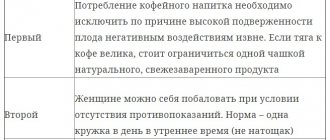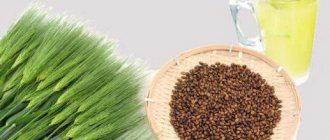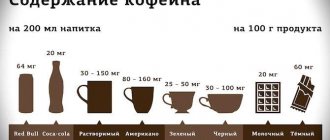Chemical composition of raw coffee beans
The biochemical formula of coffee is quite complex. The basis of the green product is water, fiber and oils. Coffee beans also contain the following components:
- caffeine;
- chlorogenic acid (gives the drink an astringent taste);
- mineral salts;
- theobromine;
- protein;
- trigonelline (during frying it contributes to the appearance of a characteristic aroma).
At least fifty percent of the composition of green grains is carbohydrates. With their help, it is possible to obtain a characteristic crema in espresso. They are the basis of the drink. It also contains a lot of acids that begin to release during heat treatment. They have a positive effect on the digestive system and the functioning of the stomach.
With the help of tannins, it is possible to obtain an astringent, bitter taste. When milk or cream is added to the drink, the structure changes and the bitterness is partially eliminated.
The caffeine contained in the beans has an invigorating effect, stimulates the activity of all systems and slightly increases blood pressure. Depending on the variety, the concentration of the alkaloid is different. It has been noted that there is more caffeine in Robusta than in Arabica. In addition, the amount of the substance depends on the method of processing the product and the growing region.
The beans also contain coffee ash, which consists of manganese, magnesium, potassium, sodium and calcium.
Composition of roasted coffee beans
During heat treatment, the composition of the coffee bean changes. The longer this process, the more significant the transformation:
- water . The liquid evaporates, the concentration of other substances, taking into account the changed mass, increases;
- sugar . When the beans are roasted, caramelization occurs and they acquire a brown tint;
- cellulose . There is a breakdown into alcohols, acids and amino acids;
- fats _ Their partial decomposition into acids is noted;
- caffeine _ After heat treatment, it is contained in the grains in almost the same quantity as initially. Taking into account the fact that the product is deprived of moisture, the concentration of dry components increases. Therefore, relative to the alkaloid content in green fruits, it becomes greater in fried ones;
- chlorogenic acid . Roasting leads to a significant decrease in its concentration, but it still remains so high that it forms a bitter taste and characteristic aroma;
- trigonneline . Heat treatment leads to the release of nicotinic acid from it.
During the process of roasting fruits, the components decompose into many organic compounds. In addition, a reaction occurs between them, as a result of which new components are formed. The result is a special aroma and taste.
The amount of antioxidants in coffee during heat treatment increases significantly as a percentage of other components.
A little history. How and by whom was caffeine discovered?
Friedrich Ferdinand Runge is a German chemist and brilliant scientist who was the first to identify caffeine.
He began his scientific experiments in his youth. But real fame and success came to him thanks to the writer Johann Goethe, a cat and coffee beans. It was Goethe who gave Runge a bag of rare coffee beans. 200 years have passed since then. Research into caffeine and its effects on the body continued. The result was the isolation of this component from tea in 1827 by M. Audry and its production artificially by G. E. Fisher in 1895. Fischer also became the first scientist to derive the structural formula of caffeine. It shows what caffeine consists of.
What does instant coffee contain?
The coffee content in instant drinks does not exceed twenty percent. This product is noticeably different in composition from the natural one. To make it, the raw materials are boiled for up to ten hours. All initially present flavoring and aromatic substances remain in the thicket, which is not used in the future. The finished product contains only the presence of an invigorating alkaloid and a small amount of acids. About eighty percent of ersatz consists of various flavor enhancers, preservatives, stabilizers, as well as dyes and flavors.
Cheap instant products may also contain chicory, but nothing is said about this on the packaging.
Even the most expensive brands do not contain one hundred percent high-quality Arabica beans. As a rule, damaged, rejected Robusta beans, characterized by a high concentration of caffeine, are used.
Vitamins and minerals
The natural product contains not only proteins, fats, carbohydrates and alkaloids, but also vitamins. The composition includes the following:
- AT 3 . It can be obtained from trigonelline under the influence of high temperatures. It has a positive effect on the nervous system and helps normalize metabolism.
- A. This vitamin has a beneficial effect on the development of all organs of the body and helps ensure that beneficial substances are absorbed into the gastrointestinal tract properly.
- E. Helps to activate the body’s protective functions and has a positive effect on the functioning of the reproductive system.
Coffee is an antioxidant, containing a considerable amount of microelements (manganese, magnesium, potassium, as well as sodium and calcium). Due to their presence, it is possible to normalize the functioning of the heart, blood vessels, and brain. In addition, muscle and bone tissues are strengthened.
Structural formula
True, empirical, or gross formula: C8H10N4O2
Chemical composition of Caffeine
| Symbol | Element | Atomic weight | Number of atoms | Mass percentage |
| C | Carbon | 12,011 | 8 | 49,5% |
| H | Hydrogen | 1,008 | 10 | 5,2% |
| N | Nitrogen | 14,007 | 4 | 28,9% |
| O | Oxygen | 15,999 | 2 | 16,5% |
Molecular weight: 194.194
Caffeine
(also mateine, guaranine) - a purine alkaloid, colorless or white bitter crystals. It is a psychostimulant and is found in coffee, tea and many soft drinks. Caffeine is found in plants such as the coffee tree, tea, cocoa, mate, guarana, cola, and some others. It is synthesized by plants to protect against insects that eat leaves, stems and grains, and to encourage pollinators. In animals and humans, it stimulates the central nervous system, increases cardiac activity, accelerates the pulse, causes dilation of blood vessels (mainly those of skeletal muscles, brain, heart, kidneys), increases urination, reduces platelet aggregation (however, in some cases, opposite effects are observed) . This is due to the fact that caffeine blocks the enzyme phosphodiesterase, which breaks down cAMP, which leads to its accumulation in cells. cAMP is a secondary transmitter through which the effects of various physiologically active substances, primarily adrenaline, are realized. Thus, the accumulation of cAMP leads to adrenaline-like effects. In medicine, caffeine is used as part of remedies for headaches, for migraines, as a stimulant of breathing and cardiac activity for colds, to increase mental and physical performance, and to eliminate drowsiness. Caffeine is included in the list of vital and essential medications.
History of discovery
It was discovered and named “caffeine” in 1819 by the German chemist Ferdinand Runge. In 1827, Udri isolated a new alkaloid from tea leaves and named it theine. Caffeine in its pure form was first obtained in 1828 (Pelletier and Cavantou). In 1832 its composition was established by Wöhler and Pfaff with Liebig. In 1838, Jobst and G. Ya. Mulder proved the identity of theine and caffeine. The structure of caffeine was elucidated towards the end of the 19th century by Hermann Emil Fischer, who was also the first person to artificially synthesize caffeine. He won the 1902 Nobel Prize in Chemistry, which he received in part because of this work.
Chemical structure and properties
The chemical name of caffeine is 1,3,7-trimethylxanthine. In an alkaline environment (at pH>9), it turns into caffeidine C7H12N4O. In structure and pharmacological properties, caffeine is close to theobromine and theophylline; all three alkaloids belong to the methylxanthines group. Caffeine acts better on the central nervous system, and theophylline and theobromine act as cardiac stimulants and mild diuretics. Caffeine, like other purine alkaloids, gives a positive murexide reaction; when heated with Nessler's reagent, caffeine forms a red-brown precipitate, in contrast to theobromine, which gives a light brown color under such conditions.
Physical properties
White needle-shaped crystals, bitter taste, odorless. It is highly soluble in chloroform, poorly soluble in cold water (1:60), easily soluble in hot water (1:2), difficultly soluble in ethanol (1:50). The solutions have a neutral reaction; sterilize at +100 °C for 30 minutes. T pl. 234 °C
Pharmacology
In small doses it has a stimulating effect on the nervous system. With prolonged use, it can cause mild dependence - theism (disease). In large doses it causes exhaustion, and in doses of 150-200 mg per kilogram of body weight (80-100 cups of coffee over a limited period of time) it causes death. Under the influence of caffeine, cardiac activity accelerates, blood pressure rises, and for about 40 minutes the mood slightly improves due to the release of dopamine, but after 3-6 hours the effect of caffeine wears off: fatigue, lethargy, and decreased ability to work appear. The physiological features of the effect of caffeine on the central nervous system were studied by I. P. Pavlov and his colleagues, who showed that caffeine enhances and regulates excitation processes in the cerebral cortex. The stimulating effect leads to increased mental and physical performance, reduced fatigue and drowsiness. Large doses can, however, lead to depletion of nerve cells. The effect of caffeine (as well as other psychostimulants) on higher nervous activity largely depends on the type of nervous system. Therefore, dosing of caffeine should be done taking into account the individual characteristics of nervous activity. Caffeine weakens the effect of sleeping pills and narcotics, increases reflex excitability of the spinal cord, and stimulates the respiratory and vasomotor centers. Cardiac activity under the influence of caffeine increases, myocardial contractions become more intense and more frequent. In collaptoid and shock conditions, blood pressure increases under the influence of caffeine; with normal blood pressure, no significant changes are observed, since simultaneously with the excitation of the vasomotor center and heart, under the influence of caffeine, the blood vessels of skeletal muscles and other areas of the body (vessels of the brain, heart, kidneys) dilate ), however, the vessels of the abdominal organs (except the kidneys) narrow. Diuresis under the influence of caffeine increases somewhat, mainly due to a decrease in the reabsorption of electrolytes in the renal tubules. Caffeine reduces platelet aggregation. Under the influence of caffeine, the secretory activity of the stomach is stimulated. According to modern data, a significant role in the mechanism of action of caffeine is played by its inhibitory effect on the phosphodiesterase enzyme, which leads to the intracellular accumulation of cyclic adenosine monophosphate (cAMP). Cyclic AMP is considered as a mediator substance (secondary mediator), with the help of which the physiological effects of various biogenic medicinal substances are carried out. Under the influence of cyclic AMP, glycogenolysis processes are enhanced, metabolic processes are stimulated in various organs and tissues, including muscle tissue and the central nervous system. It is believed that caffeine stimulation of gastric secretion is also associated with an increase in the content of cyclic AMP in the gastric mucosa. In the neurochemical mechanism of the stimulating effect of caffeine, an important role is played by its ability to bind to specific “purine” or adenosine receptors in the brain, the endogenous agonist for which is the purine nucleoside, adenosine. The structural similarity of the caffeine and adenosine molecules contributes to this. Since adenosine is considered a factor that reduces excitation processes in the brain, replacing it with caffeine leads to a stimulating effect. With prolonged use of caffeine, new adenosine receptors may be formed in brain cells, and the effect of caffeine gradually decreases. However, with a sudden cessation of caffeine administration, adenosine occupies all available receptors, which can lead to increased inhibition with symptoms of fatigue, drowsiness, depression, etc.
Application
Due to the stimulating properties of caffeine and the physical addiction to it, many people use caffeine-containing products (drinks) for a pick-me-up. Coffee is most often drunk in the morning to quickly recover from sleep. Teas (black, green) are drunk at any time of the day, usually after meals. Because tea is often drunk for its taste or to quench thirst, decaffeinated teas are produced that do not have the (sometimes undesirable) properties of CNS stimulation and blood pressure raising. Decaffeinated coffee is also available. In medicine, caffeine (and caffeine sodium benzoate) is used for infectious and other diseases accompanied by depression of the functions of the central nervous system and cardiovascular system, for poisoning with drugs and other poisons that depress the central nervous system, for cerebral vascular spasms (migraines, etc.), to increase mental and physical performance, to eliminate drowsiness. Caffeine is also used for enuresis in children. Caffeine is also used as a diuretic. Caffeine is an active ingredient in most “energy drinks” (most of these drinks contain 250-350 mg/l, but some energy drinks, particularly those made for athletes, can contain tens of times more caffeine). Caffeine is an ingredient in “energy gummies” (most contain 50-75 mg, but some STAY ALERT® energy gummies, particularly those manufactured for the US Army, contain up to 100 mg caffeine). The caffeine content in coffee is 380-650 mg/l, in instant coffee - 310-480 mg/l, in Espresso coffee - 1700-2250 mg/l. The drink "Cola" contains about 100 mg/l of caffeine. The caffeine content in tea varies over a fairly wide range - up to 5-6 times in a dry leaf - depending on the variety and age of the tea bush, time of collection, duration of fermentation and other factors. In brewed tea, the caffeine content largely depends on the brewing method (duration, water temperature) and can also differ significantly. In most cases, the caffeine content in brewed tea is in the range of 180-420 mg/l. The caffeine in tea has a milder, but longer-lasting effect than the caffeine in coffee. “Caffeine-free” products still contain it, but in reduced quantities. For example, decaffeinated black tea usually contains from 8 to 42 mg of caffeine per 1 liter of drink. In the US, decaffeination means a product contains 2.5% caffeine or less.
Pharmacotherapeutic properties
The psychostimulating effect of caffeine is based on its ability to suppress the activity of central adenosine receptors (A1 and A2) in the cerebral cortex and subcortical formations of the central nervous system. It has now been shown that adenosine (an intermediate product of ATP metabolism) plays the role of a neurotransmitter in the central nervous system, agonistically influencing adenosine receptors located on the cytoplasmic membranes of neurons. Excitation of type I adenosine receptors (A1) by adenosine causes a decrease in the formation of cAMP in brain cells, which ultimately leads to inhibition of their functional activity. Blockade of A1-adenosine receptors helps to stop the inhibitory effect of adenosine, which is clinically manifested by an increase in mental and physical performance. However, caffeine does not have the selective ability to block only A1-adenosine receptors in the brain, and also blocks A2-adenosine receptors. It has been proven that activation of A2-adenosine receptors (most likely presynaptic heteroreceptors) in the central nervous system is accompanied by suppression of the functional activity of D2 dopamine receptors. Blockade of A2-adenosine receptors by caffeine helps restore the functional activity of D2 dopamine receptors, which also contributes to the psychostimulating effect of the drug.
Indications
- decreased mental and physical performance;
- drowsiness;
- depression of the central nervous system, vascular and respiratory systems (mild poisoning with opioid analgesics and hypnotics);
- enuresis in children;
- headache of vascular origin.
Side effects
From the side of the central nervous system: excitement, anxiety, tremor (trembling of fingers and toes), anxiety, headache, dizziness, convulsions, increased reflexes, increased muscle tone, tachypnea, insomnia; with sudden withdrawal - increased inhibition of the central nervous system (fatigue and drowsiness). From the gastrointestinal tract: nausea, vomiting, exacerbation of peptic ulcer. From the cardiovascular system: increased heart rate, tachycardia, arrhythmia, increased blood pressure.
Overdose
Symptoms - abdominal pain, agitation, anxiety, mental and motor agitation, confusion, delirium (dissociative), dehydration, tachycardia, arrhythmia, hyperthermia, frequent urination, headache, increased tactile or pain sensitivity, tremor or muscle twitching; nausea and vomiting, sometimes with blood; ringing in the ears, epileptic seizures (in case of acute overdose - tonic-clonic seizures). Caffeine in doses of more than 300 mg per day (including against the background of coffee abuse - more than 4 cups of natural coffee, 150 ml each) can cause anxiety, headache, tremor, confusion, extrasystole.
Contraindications
Caffeine, like other central nervous system stimulants, is contraindicated in cases of increased excitability, insomnia, severe hypertension and atherosclerosis, organic diseases of the cardiovascular system, old age, and glaucoma. Taking caffeine accelerates the growth of cysts in patients with polycystic disease.
Receipt
Caffeine is extracted from waste tea and coffee beans. Industrially, caffeine is synthesized from uric acid and xanthine. Traditional synthesis from uric acid consists of 2 stages: The action of formamide on uric acid, resulting in the formation of xanthine. At the 2nd stage, xanthine undergoes methylation with dimethyl sulfate, depending on the conditions, it is possible to obtain caffeine and theobromine. Caffeine is obtained in a slightly alkaline environment at pH = 8.0-9.0. If methylation occurs in the presence of KOH and methanol at 60-70 ° C, then theobromine is formed. The caffeine yield reaches an average of 65-70%. The most widely used semi-synthetic method is the method developed by O. Yu. Magidson and E. S. Golovchinskaya, in which the starting product is uric acid. The method boils down to heating uric acid with acetic anhydride in the presence of a catalyst (dimethylaniline, pyridine) to form 8-methylxanthine. The reaction proceeds through intermediate opening of the imidazole ring in the purine system, decarboxylation and elimination of acetic acid. The resulting 8-methylxanthine is methylated, and depending on the reaction conditions, 1,3,7,8-tetramethylxanthine or 3,7,8-trimethylxanthine can be obtained. When methylation of 8-methylxanthine with an excess of dimethyl sulfate in a slightly alkaline medium, 1,3,7,8-tetramethylxanthine is obtained, and when methylated with benzene (toluene) sulfonic acid methyl ester (220-230 ° C in the presence of CaO), 3,7,8- is obtained trimethylxanthine (8-methyltheobromine) The order of substitution in the purine nucleus depends on the “acidity” of the corresponding hydrogen atoms. Hydrogen atoms in positions 3,7 have similar acidity, while the hydrogen atom in position 1 has lower acidity. In accordance with this, when methylating xanthine, the order of substitution is 3,7 and 1. To obtain caffeine and theobromine from 8-methylcaffeine and 8-methyltheobromine, respectively, it is necessary to remove the methyl group from position-8. For this purpose, the resulting tri- and -tetramethyl xanthine derivatives are subjected to chlorination. The direction of the chlorination process depends mainly on the temperature conditions of the reaction. At temperatures below 8-10° C, chlorine replaces hydrogen with a methyl group at C8, and at a temperature of ~80° C, not only the CH3 group at position 8 is chlorinated, but at the same time one hydrogen atom in the methyl group at C7 is replaced by chlorine. With subsequent hydrolysis of the corresponding chlorine derivatives, caffeine and theobromine are obtained. There is also a synthesis from cyanoacetic acid and dialkylurea developed by Moritz Traube. This method is the most economical.
How much caffeine is in one cup
The concentration of caffeine in coffee depends on several factors:
- Variety Arabica has a higher flavor profile than Robusta. At the same time, the amount of alkaloid in it is significantly less. In a 170 milliliter cup of a robusta-based drink, there will be about 200 milligrams of invigorating substance. In the same cup of Arabica coffee there will be no more than 110 milligrams.
- Degree of roasting . The longer the grains undergo heat treatment, the stronger the drink will be.
- Grinding _ When choosing a coffee preparation method, it is extremely important to consider the degree of grinding of the product. When using a French press or drip coffee maker, large fractions are used. When brewing in a Turk, the grains must be ground into dust. The finer the grinding degree, the greater the amount of alkaloid will be washed out with water, and accordingly, the concentration will be higher.
- Duration and method of preparation. The longer the brew takes, the more caffeine will be in the drink. Therefore, when using a French press, it will be stronger than when using a steam ristretto. Espresso has a higher strength (1700-2250 milligrams per liter); the concentration of alkaloid is lower when using Turkish coffee (380-650 milligrams per liter). A cappuccino has only 350-400 milligrams per liter, and a latte has 270-400 milligrams per the same volume. In addition, if you add not one teaspoon of ground product to the water, but two, the coffee will also be stronger.
This is how it is possible to determine the concentration of the alkaloid in a cup of various coffee drinks:
- espresso – 40-78 milligrams;
- when brewing in a Turk - 80-130 milligrams per 200 milliliter cup;
- cappuccino – 70-80 milligrams;
- instant coffee – 40-100 milliliters;
- decaffeinated – from 2 to 5 milligrams.
Coffee beans are characterized by the presence of a huge number of components. Thanks to their presence, the drink acquires such a refined taste and aroma and has an invigorating effect. In addition, when consumed in moderate doses, it has a beneficial effect on the body.
Decaffeination or how decaffeinated coffee is made
Coffee invigorates and, in reasonable doses, has a positive effect on the body of a healthy person. But people with cardiovascular diseases, pregnant women and children should avoid drinking this drink. What should those who love hot aromatic coffee do, but for one reason or another have contraindications?
Now many people know about the existence of decaffeinated coffee. But not everyone knows how this process happens. According to legend, the invention of decaffeination technology became possible thanks to chance. In 1903, the ship carrying coffee was caught in a storm and the cargo got wet. Ludwig Rosemus examined the beans and found that they were decaffeinated but still usable.
The main task of decaffeination is not only to make coffee safe for the body, but also to preserve its taste and aroma. Nowadays, technology has become so advanced that it is very difficult to distinguish between decaffeinated and decaffeinated coffee. There are several hundred ways of decaffeination. In any of them, green grain is processed. Three main methods are especially worth noting.
This method is the simplest and least expensive. The whole process looks like this:
- Green coffee beans are poured with hot water (but not boiling water) or treated with steam for 30 minutes.
- They are then immersed in solvents (methylene chloride or ethylene citate are most often used), which remove the alkaloid. This stage lasts on average 10 hours.
- After this, the grains are washed again in hot water to remove excess solvent.
- The final stage is drying.
The caffeine content with this method ranges from 1% to 3%. Among the disadvantages, it is worth noting the loss of taste and some useful substances due to the use of chemical solvents.
This method is newer and more expensive. It was introduced into use by the Swiss. The advantage of Swiss technology is that no chemicals are used in the process. Decaffeination stages:
- Green coffee beans are soaked in hot water.
- Next, the water is drained and caffeine is removed from it using a filter.
- After this, a new batch of grains is poured with water with flavor components dissolved in it. The result is a drink that is not inferior to natural coffee.
The use of carbon dioxide to decaffeinate beans was first proposed in Germany. This method was patented in 1970. The process consists of the following steps:
- First, the coffee beans are soaked in hot water.
- Next, they are placed for 10 hours in compressed carbon dioxide with a small amount of water (about 3%). The temperature should be 70 °C. Carbon dioxide will turn into liquid and act as a solvent.
- After the required time has passed, the grains are dried and roasted.
This technology allows you to preserve all the taste and aroma of coffee beans. And carbon dioxide leaves no traces behind. Accordingly, the resulting product is a healthy, aromatic drink.











